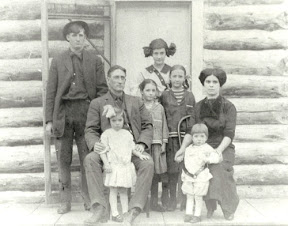 |
| Untitled news item, Bonners Ferry Herald (Bonners Ferry, Idaho), 22 September 1916, p. 4, col. 4; digital image, Newspapers.com (https://www.newspapers.com : 30 October 2024). |
The continued hearing in the case of the state against Stephen Martin, charged with being a juvenile delinquent, was heard by Probate Judge O'Callaghan last Monday. Judge O'Callaghan took the case under advisement and will render a decision Monday.
The following week a Herald journalist wrote these paragraphs which appear to be not just reporting Stephen's sentencing, but an op-ed piece about the County Auditor:
 |
| "County Business Plus Politics," Bonners Ferry Herald (Bonners Ferry, Idaho), 29 September 1916, p. 10, col. 1; digital image, Newspapers.com (https://www.newspapers.com : 12 November 2024). |
County Business Plus Politics
Stephen Martin, who on Monday in Judge O'Callaghan's court was held to be a juvenile delinquent and who was ordered committed to the Idaho State Industrial cshool [sic] at St. Anthony, left last evening for the state school in the custody of County Auditor Stanley.
Just at this time this comes as an interesting bit of news owing to the fact that recently the county auditor alleged the duties of his office required two deputies (at a total salary of $150 monthly) and that he could not get along with less help. Nevertheless the county auditor finds time to assume the role of state land appraiser upon occasions and to act as a guard when an opportunity presents itself to visit other towns of the state, presumably at the expense of the county, all of which needs but little explanation when it is remembered that Mr. Stanley is the democratic nominee for congressman. The trip to St. Anthony should give Auditor Stanley a good chance to look after his political fences.
The final article I found was a notice published also on 22 September 1916 by the Martins' neighbor, John V. Witt, who you may recall reported in the article "Ike Martin Freed By Jury" that "Sunday evening someone fired a bullet from a high-power rifle through the front door of his house, the bullet passing a little over the head of his sleeping baby. On Monday Mrs. Witt was badly frightened when the clothes she was hanging up to dry were peppered with shot from a shotgun." The insinuation was that it was the Martins doing the shooting.
 |
| "Notice to Hunters in Katka District," Bonners Ferry Herald (Bonners Ferry, Idaho), 22 September 1916, p. 6, col. 1; digital image, Newspapers.com (https://www.newspapers.com : 30 October 2024). |
Notice to Hunters in Katka District
On and after this date there shall be no hunting upon the ground enclosed by my fence as I have taken notice that some people haven't sufficient brains to use a gun with safety to the general public. I have to take these precautions to protect the lives of my wife and baby. Any person or persons found hunting on my premises will be prosecuted.
September 15, 1916
(Signed) JOHN V. WITT. tf
I had not heard of the Idaho State Industrial School, so I did a Google search. Sometimes called the Idaho State Reform School, it was located in St. Anthony, Fremont County, Idaho. Founded in 1903, it housed wayward youth in conditions so bad that reportedly, some inmates chose to take their own lives. A Wikipedia article discusses the Women's Dormitory which is now on the National Register of Historic Places. A PDF document published by the Idaho Historical Society details the nomination of the dormitory to the National Register. The Men's Dormitory likely looked similar.
I wondered if Stephen was still an inmate when the 1920 Federal Census was taken four years later, but reviewing the census records for the school, line by line, did not yield his name. In fact, I could not find him at all on this census, any where in the United States, even in his parents' home. By 1920, the Martin family had moved to Kahlotus, Franklin County, Washington, over 200 miles southwest of their former home in Katka, Idaho.1 They had sold their home in 19192 and moved to Washington; whether it was because of the neighborhood tensions or because Frank's job as a "railroad boss", or perhaps both. It's likely that Stephen had served his time and had moved on.
P.S. Check out the link in the second source below to see a 1910 photo postcard of the Martin's home in Katka and a short article from the Bonner County Historical Society & Museum. Steve is likely the smallest boy on the left wearing overalls.
Sources:
1. 1920 U.S. census, Franklin County, Washington, population schedule, Kahlotus Precinct, p. 1B, dwelling 21, family 21, Frank J. Martin household; digital image, Ancestry.com (http://www.ancestry.com : accessed 12 March 2014), image 2 of 9.
2. ---, "From the Archives," Bonners Ferry (Idaho) Herald, 16 September 1921; digital image, BonnersFerryHerald.com (https://bonnersferryherald.com/news/2021/sep/16/archives-sept-16-2021: accessed 4 February 2025).









